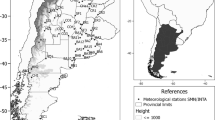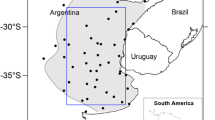Abstract
This study aims to evaluate soil climate quantitatively under present and projected climatic conditions across Central Europe (12.1°–18.9° E and 46.8°–51.1° N) and the U.S. Central Plains (90°–104° W and 37°–49° N), with a special focus on soil temperature, hydric regime, drought risk and potential productivity (assessed as a period suitable for crop growth). The analysis was completed for the baselines (1961–1990 for Europe and 1985–2005 for the U.S.) and time horizons of 2025, 2050 and 2100 based on the outputs of three global circulation models using two levels of climate sensitivity. The results indicate that the soil climate (soil temperature and hydric soil regimes) will change dramatically in both regions, with significant consequences for soil genesis. However, the predicted changes of the pathways are very uncertain because of the range of future climate systems predicted by climate models. Nevertheless, our findings suggest that the risk of unfavourable dry years will increase, resulting in greater risk of soil erosion and lower productivity. The projected increase in the variability of dry and wet events combined with the uncertainty (particularly in the U.S.) poses a challenge for selecting the most appropriate adaptation strategies and for setting adequate policies. The results also suggest that the soil resources are likely be under increased pressure from changes in climate.



Similar content being viewed by others

References
Allen GA, Pereira LS, Raes D, Smith M (1998) Crop evapotranspiration: guidelines for computing crop water requirements, Irrigation and Drainage Paper No. 56. FAO, Rome, 300 pp
D´Odorico P, Porporato A (2004) Preferential states in soil moisture and climate dynamics. Proc Natl Acad Sci U S A 101:8848–8851
Dokučhaev VV (1883) Russian Chernozem. Israel Program for Scientific Translations, Jerusalem 1967
Dubrovský M, Buchtele J, Zalud Z (2004) High-frequency and low-frequency variability in stochastic daily weather generator and its effect on agricultural and hydrologic modelling. Clim Chang 63:145–179
Dubrovský M, Nemešová I, Kalvová J (2005) Uncertainties in climate change scenarios for the Czech Republic. Clim Res 29:139–156
Eckmeier E, Gerlach R, Gehrt E, Schmidt MWI (2007) Pedogenesis of chernozems in Central Europe-a review. Geoderma 139:288–299
Ellenberg H (1974) Zeigerwerte der Gefäßpflanzen Mitteleuropas. Scr Geobotanica 9, 97 pp
Fanning DS, Fanning MCB (1989) Soil morphology, genesis and classification. Wiley, New York, 395 pp
Farr TG, Rrosen P, Caro E et al (2007) The Shuttle radar topography Mission. Rev Geophys 45, RG2004
Fischer G, van Velthuizen H, Shah M, Nachtergaele F, (2002) Global agro-ecological assessment for agriculture in the 21st century: methodology and results, IIASA, (http://webarchive.iiasa.ac.at/Admin/PUB/Documents/RR-02-002.pdf)
Gray JM, Humphreys GS, Deckers JA (2009) Relationships in soil distribution as revealed by a global soil database. Geoderma 150:309–323
Harvey LDD, Gregory J, Hoffert M et al (1997) An introduction to simple climate models used in the IPCC Second Assessment Report. IPCC Tech Paper 2. Intergovernmental Panel on Climate Change, Geneva
Hassan R, Scholes R, Ash N (eds) (2005) Millenium ecosystem assessment, volume I. Ecosystems and human well-being: current state and trends: findings of the Condition and Trends Working Group, 917 pp
Hirschi M, Seneviratne SI, Alexandrov V, Boberg F, Boroneant C, Christensen OB, Formayer H, Orlowsky B, Stepanek P (2010) Observational evidence for soil-moisture impact on hot extremes in southeastern Europe. Nat Geosci 4:17–21
Hlavinka P, Trnka M, Balek J et al (2011) Development and evaluation of the SoilClim model for water balance and soil climate estimates. Agric Water Manag 98:1249–1261
Homer C, Huang C, Yang L, Wylie B, Coan M (2004) Development of a 2001 national landcover database for the United States. Photogramm Eng Remote Sens 70:829–840
Hulme M, Wigley TML, Barrow EM, Raper SCB, Centella A, Smith S, Chipanshi AC (2000) Using a climate scenario generator for vulnerability and adaptation assessments: MAGICC and SCENGEN Version 2.4 Workbook. Climatic Research Unit, Norwich
Jenny H (1941) Factors of soil formation-a system of quantitative pedology. McGraw-Hill, New York, 281 pp
Jenny H (1961) Derivation of state factor equations of soils and ecosystems. Proc Soil Sci Soc Am 25:385–388
Jones A, Stolbovoy V, Rusco E, Gentile AR, Gardi C, Marechal B, Montanarella L (2009) Climate change in Europe. W. Impact on soils. A review. Agron Sustain Dev 29:423–432
Kruijt B, Witte JPM, Jacobs CMJ, Kroon T (2008) Effects of rising atmospheric CO2 on evapotranspiration and soil moisture: a practical approach for the Netherlands. J Hydrol 349:257–267
Lang R (1920) Verwitterung und Bodenbildung als Einführung in die Bodenkunde, Stuttgart
Larcher W (2003) Physiological plant ecology, 4th edn. Springer, Berlin, 513 pp
Marbut CF (1928) A scheme for soil classification. 1st Internal. Cong Soil Sci Comm 5, Proc Papers 4:1–31, illus
Marbut CF (1935) Soils of the United States. In U.S. Dept. of Agric. atlas of American agriculture, pt. III. Advance Sheets, No. 8., 98 pp., illus
Miller DA, White RA (1998) A conterminous United States multi-layer soil characteristics data set for regional climate and hydrology modeling. Earth Interact 2. [Available on-line at http://EarthInteractions.org]
Mitchell TD (2003) Pattern scaling. An examination of the accuracy of the technique for describing future climates. Clim Change 60:217–242
Munson SM, Belnap J, Okin GS (2011) Responses of wind erosion to climate-induced vegetation changes on the Colorado Plateau. Proc Natl Acad Sci U S A 108:3854–3859
Murer E, Wagenhofer J, Pfeffer M (2004) Die nutzbare Feldkapazität der mineralischen Böden der landwirtschaftlichen nutzf läche Österreichs. Schriftenreihe BaW 20:72–78
Novák V (1921) Vztahy mezi podnebím a půdou se zřetelem ku půdám Čech (Relationship bewteen climate and soil with regard to soils in Bohemia). In: Czech with German and French resumes; Prague, 140 pp
Orchard VA, Cook FJ (1983) Relationship between soil respiration and soil moisture. Soil Biol Biochem 15:447–453
Pelíšek J (1966) Altitudinal zonation of soils in Central Europe (In. Czech). Academia, Prague, p 368
Rounsevell M, Evans SP, Bullock P (1999) Climate change and agricultural soils: impacts and adaptation. Clim Chang 43:683–709
Santer BD, Wigley TML, Schlesinger ME, Mitchell JFB (1990) Developing climate scenarios from equilibrium GCM results. Report no.47. Max Planck Institute für Meteorologie, Hamburg
Schaetzl RJ, Anderson S (2005) Soils genesis and geomorphology. Cambridge University Press, Cambridge, p 817
Seneviratne SI, Lüthi D, Litschi M, Schär C (2006) Land–atmosphere coupling and climate change in Europe. Nature 443:205–209
Seneviratne SI, Corti T, Davin EL et al (2010) Investigating soil moisture-climate interactions in a changing climate: a review. Earth Sci Rev 99:125–161
Sivakumar MVK, Stefanski R (2006) Climate and land degradation—an overview. International Workshop on Climate and Land Degradation. Clim Land Degrad 105–135. Arusha, Tanzania
Soil Atlas of Europe (2005) European soil bureau network, European Commission, Office for Official Publications of the European Communities, L-2995 Luxembourg, EUR-216766 128 pp
Solomon S, Qin D, Manning M (2007) Contribution of working group I to the fourth assessment report of the intergovernmental panel on climate change. Cambridge University Press, Cambridge, 996 pp
Teuling AJ, Hirschi M, Ohmura A (2009) A regional perspective on trends in continental evaporation. Geophys Res Lett 36, L02404. doi:10.1029/2008GL036584
Tomášek M (2007) Soils of the Czech Republic. Czech Geological Service, Prague, 68 pp
Trnka M, Dubrovsky M, Semeradova D, Zalud Z (2004) Projections of uncertainties in climate change scenarios into expected winter wheat yields. Theor Appl Climatol 77:229–249
USDA-NRCS-Soil Survey Staff (1975) Soil taxonomy. A basic system of soil classification for making and interpreting soil surveys. USDA soil conservation service, Agric. Handbook No 436. U.S. Government Printing Office, Washington
USDA-NRCS-Soil Survey Staff (1999) Soil taxonomy, a basic system of soil classification for making and interpreting soil surveys. USDA-soil conservation service, agricultural handbook #436, 2nd edn. U.S. Government Printing Office, Washington, 869pp
Van Wambeke A, Hastings P, Tolomeo M (1992) Newhall simulation model—A BASIC Program for the IBM PC (DOS 2.0 or later). Dept. of Agronomy, Cornell University, Ithaca
Várallyay G (1994) Soil responses to climate change. In: Rounsevell MDA, Loveland PJ (eds) Nata ASI series, 123. Springer, Heidelberg, pp 39–54
Waltman WJ, Ciolkosz EJ, Mausbach MJ, Svoboda MD, Miller DA, Kolb PJ (1997) Soil climate regimes of Pennsylvania. Pennsylvania Ag Expt Sta Bull 873
Waltman WJ, Goddard S, Reichenbach SE, Svoboda MD, Hayes MJ, Peake JS (2003) Patterns and trends of soil climate regimes and drought events in the Northern Great Plains, Proceedings of the Applied Geography Conference. Colorado Springs, Colorado
Acknowledgments
Projects KONTAKT, LH110010 and National Agency for Agricultural Research QI91C054 helped plan and execute this study. Dr. Trnka was supported by the project “Establishment of International Scientific Team Focused on Drought Research” (no. OP VK CZ.1.07/2.3.00/20.0248). Dr. Dubrovský was supported by the FP 7 project CLIMSAVE (no. 244031). Dr. Hlavinka was supported by project “Partnership in Climate Research and Adaptation Strategies (no. CZ.1.07/2.4.00/31.0056). We would like to thank Deborah Wood(NDMC) for careful language editing of the final version of the paper and to three anonymous reviewers for helpful comments.
Author information
Authors and Affiliations
Corresponding author
Rights and permissions
About this article
Cite this article
Trnka, M., Kersebaum, K.C., Eitzinger, J. et al. Consequences of climate change for the soil climate in Central Europe and the central plains of the United States. Climatic Change 120, 405–418 (2013). https://doi.org/10.1007/s10584-013-0786-4
Received:
Accepted:
Published:
Issue Date:
DOI: https://doi.org/10.1007/s10584-013-0786-4



